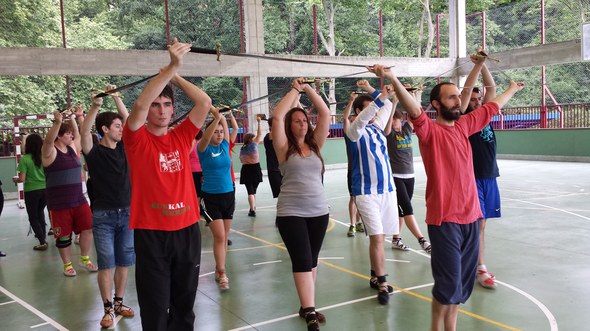basque heritage worldwide

07/28/2014

ADVERTISING
Vitoria-Gasteiz. Now that Gaztemundu 2014 is over, the organizers as well as the participants have shown their satisfaction with the results of the experience. “The evaluations were very positive, and we have seen that the students were very happy and have confirmed that the work done by Oier Araolaza and the professors was extraordinary,” Asier Vallejo, director of Basque Communities Abroad, told EuskalKultura.com.
The 25 participants in Gaztemundu, dance directors and instructors from the Diaspora received an intensive course from July 6-20th. “They had a unique opportunity, an opportunity that the dantzaris here don’t even have,” Araolaza told our bulletin. “To learn all of this (on your own) it would take years, studying here and there.” That is why some of the classes were open to local dancers, with the added intention of creating a network between all the participants.

[One of the classes at Gaztemundu 2014 (photoDantza.com)]
Inundated by information
During the two-week course, intensive and varied, Gaztemundu participants were “inundated by information,” said Araolaza. They worked on the traditions of all seven provinces with professors from various dance groups: Ander Abuin taught dances from Lesaka; Jon Iruretagoiena and Claude Iruretagoiena dances from Lapurdi, Behe-Nafarroa and Zuberoa; a group of dance masters from the Argia dance group – Fernando Aristizabal, Iñaki Arregi, Jexux Larrea and Jokin Otamendi – Gipuzkoan traditions; Josu Garate and Oier Araolaza, Gipuzkoan ezpatadantza, and Jon Fernandez and Amagoia Egiluz, dances from Araba…

[Jauzi! Practical classes got the dancers sweating (PhotoDantzan.com)]
The Lehendakari, Txistulari
Oier Araolaza and his Dantzan Ikasi project partners chronicled the entire course on their website Dantzan.com. Among those was one of the most curious moments of this year’s Gaztemundu, on July 9th, at the reception for participants by Lehendakari Iñigo Urkullu when the dancers danced the soka-dantza in the patio of the Lehendakaritza.

[Dancing the soka-dantza for Maria Angeles Elorza, Secretary-General of Foreign Action; Lehendakari Iñigo Urukullu and his wife Lucia Areita-Araunabeña and Asier Vallejo, Director for the Basque Community Abroad (photoDantzan.com)]
“The group was nervous having just arrived for the course,” Araolaza explained. “At the end, everyone was surprised to see the Lehendakari approach the txistulari Jose Migel Laskurain, and ask permission to play his txistu and drum. He then started to play Ikusi Mendizaleak.”

[Members of Gaztemundu accompanied the Lehendakari by singing and applause (photoDantza.com)]
Araolaza explains the moment on his chronicle: “The Lehendakari had played the txistu and drum for years, and showed us that he hadn’t forgotten. But afterwards, we continued talking, and we realized that besides playing the txistu he also follows the world of Basque dance, and Basque folklore with great interest.”
Second phase
Now that the course is over, the hardest part begins: remembering and assimilating all that was learned in the Basque clubs. “Instead of saying that the course if over, we should say that it is now in its second phase,” said Araolaza. “Besides, everyone knows that we support the dance community through Dantzan.com and now that we know each other we hope that they will take advantage of this service.”
ADVERTISING
ADVERTISING
ADVERTISING
ADVERTISING
ADVERTISING
© 2014 - 2019 Basque Heritage Elkartea
Bera Bera 73
20009 Donostia / San Sebastián
Tel: (+34) 943 316170
Email: info@euskalkultura.eus